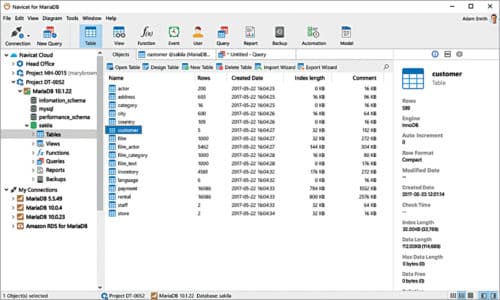Relational database management system (RDBMS) tools are essential for software developers. These are expected to be reliable, quick and secure. Among the large number of database systems out there, MariaDB stands out. Forked out from MySQL, MariaDB remains compatible with its parent system. It is used by the likes of Google, Mozilla, WordPress and Wikipedia. Let’s see what makes MariaDB so useful.
Working on MariaDB
MariaDB is an open source RDBMS that utilises MySQL code as the development platform. So it essentially acts as a drop-in replacement for MySQL, that is, you can replace the MySQL software with MariaDB without any necessary code or major setup changes.
The MySQL code has been cleaned up and shaped into a more stable and lighter database version. The best part of MariaDB is support for third-party software and its own storage engines—which we will discuss later in the article.
MariaDB is compatible with many platforms including Windows, MacOS and Linux distributions. Installation is easy and well instructed through setup files. You can use command line instructions for installation as root-user (if permission is available). Replacing existing MySQL setup with MariaDB is simple as well.

User authentication is required to start coding in MariaDB platform. The SQL environment is quite similar to most RDBMS, especially MySQL. The top bar has various menus like File, View, Favourites, Tools, Windows and Help. You can explore these to understand the different functions you can perform in the software.
Below the menu bar are a few essential quick buttons. For instance, Connection allows you to provide credentials for the database connection you want to work on. User lets you handle the user login. You can perform operations related to Tables, Views, Functions, Events or even Queries with the buttons that follow.
The left side of the screen contains a panel that categorises all the elements of the database. At the top it shows the connection server to which you presently logged in. Below that you will see the database being used. Different existing components of the database like tables, views, functions, events, queries, reports and backups can be viewed.
The middle of the interface is the main workspace, where queries can be coded and results viewed. It follows simple structured query language (SQL) syntax. On successful execution of a query, results in table format are displayed in a new tab on the workspace. Table Relational diagrams and key-based connections can be viewed in the database workbench, providing a clear graphical interface.

Features in Version 10.2
Going by user reviews, MariaDB is one of the smoothest RDBMS. Its read and write functions are quick with fast retrieval of query data. Support for all types of DBMS features like user-defined functions, stored procedures and views makes this DBMS very useful.
As mentioned earlier, it comes with multiple storage engines. Version 10.2 uses InnoDB as the default storage engine replacing XtraDB from the earlier iterations.
Apart from that, MariaDB adds TokuDB for fractal index storage, MyISAM for non-transactional data storage, Sequence storage engine, SphinxSE for text search, Spider storage engine, Cassandra and CONNECT for legacy database, and NoSQL backends. This also means it has a certain amount of NoSQL support. MyRocks is another storage engine that allows big data compression without compromising the speed.
Other than storage engines, there is a massive list of third-party plugin support as well. For instance, Version 10.2 supports AWS key encryption plugin. There are plugins for Archive, Audit, Client Statistics, Memory, Performance_Schema, Partition, Server Audit and more. To check all the plugins and their integration maturity level in MariaDB, type the following
SQL command:
SELECT plugin_name, plugin_version, plugin_maturity FROM information_schema.plugins ORDER BY plugin_name;
JSON functionality has also been added and supports CREATE TABLE command. Support for common table expressions eliminates the need of temporary tables for complex SQL.
The latest version has added compatibility for multiple triggers on the same event, which can be a handy feature. Moreover, a Flashback feature has been added. It can do a rollback function for databases, tables and instances to an old snapshot. Optimal import and export of CSV and XML files provide added advantage.

The final word
MariaDB developers plan to add rollback on DML statements as well. MariaDB’s scalability and versatility have made it the RDBMS of choice for users of every scale. The open source community brings transparency to developmental steps and upgrades made.
Upgrades and security features are available with proper documents and release notes. With a strong community support and global usage, MariaDB is a great database system to go ahead with.






